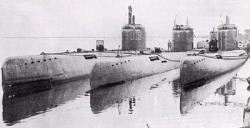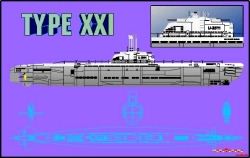| Type XXI U-boat From U-boat Net |
||||
|
This was the boat that could have won the war in the Atlantic for the Germans had she been in the water maybe 2 years earlier. She was the first real combat submarine that was meant to dwell in the deep and not just retreat to it once in danger. These boats had much better crew facilities than previous classes, were much more silent underwater, had freezer for foodstuffs, a shower and a basin and little things like that. They also had a hydraulic torpedo reload system that enabled the commander to reload all 6 tubes in 10 minutes, less than it took to reload one tube on the Type VIIC. WIth 3-times the electrical power of the VIIC, the Type XXI had enormous underwater range compared to the older types. Moreover, this boat could submerge far beyond the Bay of Biscay from the French bases, so the Valley of Death became a thing of the past for them. It took the boat 3-5 hours to re-charge the batteries with the Schnorchel once every 2-3 days if travelling at moderate 4-8 knots. As a result, there were in less danger from aircraft, which sank about 56% of all U-boats lost in the war. Initial Trials The initial trials with the first available Type XXIs showed that the theoretical performance was almost met. The full submerged speed was 17 knots and could be maintained for a shorter time than hoped (60-80 minutes instead of 100). Overall, the performance was outstanding and offered much better prospects for attacking convoys and evading escorts than conventional U-boats. At the silent submerged cruising speed the Type XXI had to schnorkel for only 3 hours a day to keep the batteries charged. At 5 knots range was 365 miles, meaning that a U-boat would pass the dangerous waters between Norway and Iceland in 5 days, schnorkeling briefly five times. The radar-search receiver Tunis, fitted to schnorkel, combined with anti-radar rubber coating offered additional safety. Even when located, an alteration of speed and course would help to evade escorts or aircraft-dropped sonar buoys. When escaping at high speed, the Type XXI was almost as fast as most of the Allied escorts. Bubbling water rushing along the hull would make ASDIC location difficult. The potential area where a hunted Type XXI, escaping at the silent speed of 5 knots, would be forced to raise the schnorkel again was some 10-13 times greater than an area for conventional U-boat (escaping at 2 knots with a range of 100 miles). With the existing anti-submarine forces search abilities a chance for a kill was therefore greatly reduced. The attack tactics were based on the following principles:
Special equipment was provided to facilitate the tactics, in particular a special echo-ranging plotting-table and an echo-ranging data converter which automatically calculated and set torpedo firing parameters. Due to the quick reload mechanism the Type XXI would need only one convoy encounter to fire all the torpedoes. The preparation of the battle instructions for Electroboats was an interactive process with constant feedback and verification coming from the training units. The final battle instructions were written by experienced commanders: Erich Topp (for the Type XXI) and Carl Emmermann (for the Type XXIII). However, others also contributed, among them Emil Klusmeier who later volunteered for a command in order to verify his ideas in practice and with U-2336 scored hits. Although the first Type XXI was launched almost on time, the Electroboat building programme was eventually delayed by various means and the planned production figures had not been met. By January of 1945, 95 of a planned total of almost 400 boats had been delivered. The failure to achieve the objectives was mainly caused by organization troubles, faulty design and bad workmanship. It was particularly annoying when sections did not fit to each other because the specified tolerances were exceeded. All these took place mainly in the first half of 1944 and were resolved in the second half of the year. At that time, however, the Allies realized the danger and started regular bombing raids, particularly on shipyards and water transport installations (needed for transportation of massive Type XXI sections). Training for the new boats Further delay in the project was caused by the extended training required for crews. The complexity of the design and new tactics meant that 6-7 months of training was required instead of the usual 3-3.5 needed for conventional U-boats. Moreover, the training facilities were affected by the Allies actions, particularly the mining of the Bay of Danzig, the primary trial and training waters. The first mines were laid on 26/7 August 1944 by Bomber Command and continued regularly, leading eventually to the total abandonment of the area. The trials and tests were moved to the Bay of Luebeck which was much inferior, particularly because the area was within the range of Coastal Command. The disruption of training meant that the Type XXI boats, with almost no exception, could not became fully operational in early 1945. Also, a number of boats that almost finished their training and awaited transfer to the Norwegian bases were lost in the dangerous Bay of Luebeck.  The following was the only one Type XXI U-boat fully ready for operations at the end of the war: 11th Flotilla, Bergen : U-2511 Commander: Korvkpt Adalbert Schnee. It is sometimes reported that U-3008 was also ready for operations. She indeed sailed from Wilhelmshaven on 3rd May 1945, when the artillery bombardment was already heard. The U-boat may have been supposed to call in one of the Norwegian ports for final provisioning before the patrol. In the North Sea, shortly after the order to surrender (issued on 4th May 1945), she encountered a convoy, made a pass under it, and sailed away undetected. Although a limited number of operations was carried out, it was proved that Type XXIII was an ideal U-boat for short operations in coastal waters. They were fast, easy to control, ready for continuous underwater operation, very difficult to locate even when surfaced, and could operate slightly longer than expected. None was lost although they were attacked. |
 The high underwater speed always allowed escape. It also allowed to gain a position advantage against a convoy, and then quickly attack two targets. Sometimes, however, the speed of the boat was underestimated by the Commander, which resulted in the second torpedo to be fired too close and thus fail to arm. The only boat to score twice was U-2336 on 7th May, which was also the last sinking by a U-boat in the war. Ironically, in this case the only significant technical weakness of Type XXIII was demonstrated - which was faulty radio equipment. U-2336 would have not attacked, had she not missed the surrender signal on 4th May. What may be a surprise is that the technology used in the design was by no means new. To characterize the concept, the following 3 features are listed:
The benefits of the streamlined hull had been known long before the era of Electroboats. In fact, the very first submarines including original Holland's vessel were more streamlined than their WW1 and WW2 succesors. Schnorchel was developed in the 30's by the Dutch, but the concept was known to the others. Adding more battery capacity is just a matter of space, not technology. Therefore, it should be noted that the technology used for Electroboats was actually available already in the 30's. Why was it not exploited? There was no need to do so as long as the U-boat was safer and performed better on the surface at night than under the surface. This was clearly demonstrated in the first few years of the U-boat War. Only when the relative safety of staying on the surface was taken away by radar and aircraft did the German Naval High Command begin looking for an alternative solution. The reason for the late introduction of Electroboats is primarily related to the failure to accurately assess Allied advances in radar technology. In this particular field the Germans were significantly behind England. Had the German radar technology been more advanced, it would probably have been realized that it was just a matter of time before the small silhouette of the surfaced U-boat was indeed large enough for radar detection. The production process of the Electroboats was also somewhat revolutionary. It was one of the few examples of the implementation of mass-production principle by the German industry during the Second World War. Of course, this too was affected by the Allied bombing, but the final number of commissioned Electroboats should be regarded as high. It is a surprise that the mass-production concept was not adopted earlier, particularly for the conventional U-boat production. A high production number of conventional U-boats in the second half of 1941, when the British counter-measures were not fully developed, (instead of 1942), would have certainly made a difference in the Axis war effort. The experience of U-2511 (see below) clearly demonstrates the outstanding performance of the Type XXI, and it is certain that the Allied navies had no ready answer to the new threat. Had the Allied progress on land been slower, the Type XXI U-boats might have appeared in numbers great enough to paralyze the Atlantic communication routes, even in spite of the increased bombing of production and training facilities. Electro boat diary:
U-2511 U-2511 left Bay of Danzig on 30 January 1945, where she absolved the usual training, but also a lot of tests with the new equipment. She headed back to he shipyard for some remaining work to be completed on the boat. On 16 March, 1945 U-2511 was the first XXI-boat to make her maiden voyage which was from Kiel in a Front-flotilla. A few days later she reached the base at Horten in Norway. There had the boat to absolved some deep diving trials. On 18 April 1945 U-2511 went to Bergen, where she arrived on 21 April. At the same time, when Hitler died in Berlin, on the evening of 30 April, 1945 U-2511 set out from Bergen for her first and also last patrol. The crew served under very experienced U-boat officers like Oak-Leaves owner Korvkpt. Adalbert Schnee, the former very successful commander of U-201 and then two years one of closest staff members of Dönitz. On board was also one of the rare LI's, which was decorated with the Knights Cross, Korvkpt.. (Ing) Gerd Suhren, Teddy Suhren's brother. The destination for that patrol was to be the Caribbean, where the boat had should be tested under all conditions. On 1 May, U-2511 had the first enemy contacts. Three days later, on 4 May, 1945 received Adalbert Schnee the cease fire orders. A few hours later U-2511 made a contact with the British cruiser HMS Norfolk among some other British warships. The boat approached to within 500 meters of the British warship without any sonar contact from the enemy destroyers. Schnee had here the possibility for a absolute deadly attack against the cruiser, but then he left the scene without attacking and headed back to base. U-2511 reached Bergen on the 5 May, 1945. There the commander a few days later had a talk with officers of the HMS Norfolk and they couldn't believe the fact, that U-2511 was able to get so close without any sonar contact. U-2511 left Bergen on 14 June, 1945 to be transferred to Lisahally, Northern Ireland, which she reached on 21 June. The boats career ended on 7 January 1946 at 1940hrs at position 55.33,08N, 07.38,07W where she was scuttled.
|
|||
|
© 1997 - 2000 COMBATSIM.COM, INC. All Rights Reserved. Last Updated February 5th, 1999 |
||||
